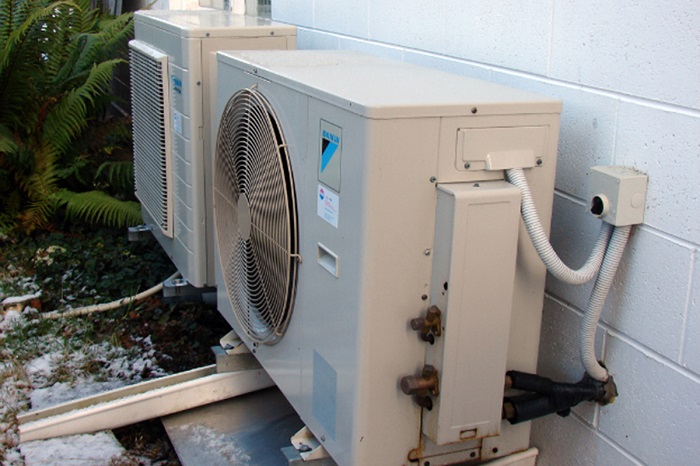EarthTalk®
From the Editors of E – The Environmental Magazine

Environmentalists like heat pumps because they use a lot less energy than baseboard electric heat and oil or gas furnaces Credit: WFIU, FlickrCC.
Dear EarthTalk: Can we mass produce heat pumps with the same effort as when the country retooled to make tanks for World War II? — Jan K., via email
Environmental advocates are bullish on heat pumps as a better choice for home heating than the traditional options.
“Heat pumps use only about a third as much electricity as baseboard electric heaters and considerably less energy than gas or oil furnaces,” reports Bob Schildgen in Sierra magazine.
“You don’t need gas or oil to operate a heat pump, as it relies only on electricity.”
Heat pumps were rare just a decade ago, but nowadays are now much more common. “The share of new homes using an air or ground source heat pump as the primary means of providing heat has increased, going from 23 percent in 2000 to 40 percent in 2021,” reports the National Association of Home Builders. “Meanwhile, the share relying on a forced air systems has slipped, going from 71 to 58 percent in the same time frame.” And in 2022, sales of heat pumps outpaced sales of gas furnaces for the first time ever.
While production is certainly ramping up on its own due to rising demand, the federal government could spearhead a more concerted effort to mandate a national switchover akin to retooling manufacturing for the WWII war effort.
Of course, doing so would be no small task. During World War II, Americans mobilized their industrial capabilities to an unprecedented level, converting existing factories and building new ones to produce large numbers of tanks, planes and other military equipment.
Similarly, to mass-produce heat pumps, it would require a substantial expansion of manufacturing capacity, including retooling existing factories or constructing new ones.
Another hurdle to overcome would be building up the supply chain. Heat pumps require various components and materials, including compressors, heat exchangers, motors and refrigerants.
Ensuring a consistent and reliable supply of these components would be essential to meet production demands. Finding large numbers of skilled workers to be trained in the intricacies of producing heat pumps would be yet another challenge to ramping up production World War II-style.
Perhaps the largest impediment of all to ramping up heat pump production way above current rates is mustering the political will to bring federal and other subsidies to bear in funding the effort.
Similar to wartime efforts, substantial government support and coordination would be essential to drive the mass production of heat pumps. This support would include financial incentives, regulatory measures and collaboration between government agencies, manufacturers and research institutions.
Such an endeavor could contribute significantly to addressing climate change and transitioning to more sustainable energy systems.
CONTACTS:
Clean Energy 101: Heat Pumps, rmi.org/clean-energy-101-heat-pumps/
“Almost Even Split Between Natural Gas and Electric Heating Systems in New Homes,” eyeonhousing.org/2022/09/almost-even-split-between-natural-gas-and-electric-heating-systems-in-new-homes
“How Can Air Source Heat Pumps Help Reduce Greenhouse Gas Emissions Even in Cold Climates?” nahb.org/blog/2021/06/How-Can-Air-Source-Heat-Pumps-Help-Reduce-Greenhouse-Gas-Emissions-Even-in-Cold-Climates
EarthTalk® is produced by Roddy Scheer & Doug Moss for the 501(c)3 nonprofit EarthTalk.
See more at https://emagazine.com
To donate, visit https://earthtalk.org
Send questions to: question@earthtalk.org
